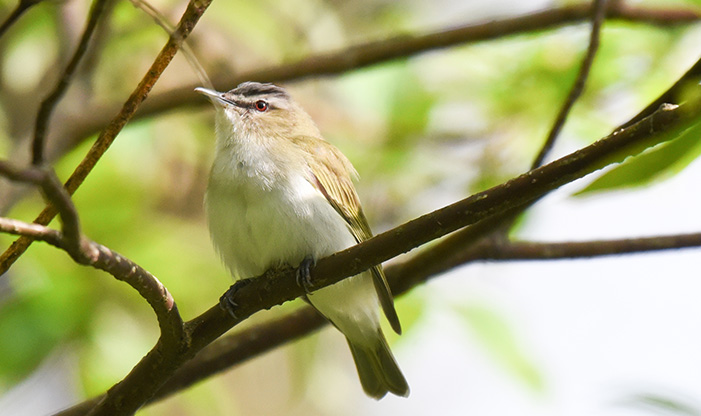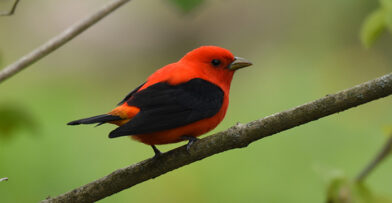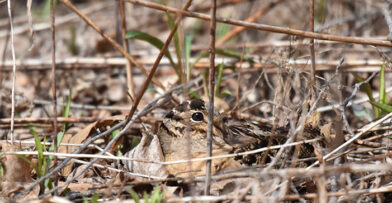Our Bird Profile series highlights a species that is migrating through, breeding, or is a year-round resident of Wisconsin that can be found at Schlitz Audubon or in your backyard.
Name
Red-eyed Vireo, Vireo Olivaceus
Basic Description & Appearance
The Red-eyed Vireo is a small neotropical songbird named for the mature bird’s red to crimson-colored eyes. It measures about 12-13 cm in length and is larger and thicker-billed than a warbler. The species displays a gray to blue-gray crown with black bar through and above the eye, contrasting grayish, olive-green colored plumage, and white underparts without wing bars. Male and female Red-eyed Vireos look similar, but are weakly sexually dimorphic, as the male is slightly larger.
Vocalizations
This bird species is often heard rather than seen. Their song consists of several short phrases, delivered consistently and strung together in upward, downward, or steady pitches sounding like cherr-o-wit, cheree, sissy-a-wit, or other song sounds. Their song has also been described as if they are asking and answering a question over and over, and that question and the answer sound like they are singing their own name, asking very quickly “red-eyed,” and answering just as quicky “vireo!” During the early part of the breeding season, the Red-eyed Vireo is known to sing for long durations.
The most common call is a mew sound like a catbird and is used when the bird is being aggressive. This species uses up to six other calls, such as when males fight or when either sex meets their partner to be a mated pair.
Habitat & Nesting
The Red-eyed Vireo’s breeding range spans across eastern North America, and north across the western United States and Canada. They overwinter in the Amazon basin of South America, east of the Andes. The vireo prefers deciduous and mixed conifer-deciduous forests, and dwells in the interior closer to the canopy. They can also live in parks, cemeteries, and residential areas – wherever large trees grow.
Breeding pairs are monogamous, with a pair forming when the female arrives to the mating grounds, 3-15 days after the male bird. Female Red-eyed Vireos build the nest, mostly in May just after forming a mated pair in mid-April, but nest building can last as late as into August. Eggs are laid 1-4 days after nest completion and then incubated for up to 14 days, with young birds staying in the nest for about 12 days. Female birds spend more time feeding and brooding the young than the male.
Diet & Foraging
During the breeding season these birds are largely insectivorous, mostly eating caterpillars, but also flies, mosquitoes, and beetles, while consuming some fruit in late summer and fall. They generally search small areas of the tree for arthropods while hopping along the branches, changing their perch by flying to a new branch every 10-15 minutes. During winter, they are almost completely frugivorous, feeding on small fruits such as elderberries, blackberries, dogwood. While migrating, the Red-eyed Vireo forages more on the ground and on tree trunks than during the breeding season.
When & Where to Find at Schlitz Audubon
Visitors will find Red-eyed Vireos usually high up in the canopy of our forest habitats during peak time from June through September, though they are present as early as April and as late as November.
Other Fun Facts
- Males can sing as many as 20,000 times per day during breeding season.
- Over 12,000 Red-eyed Vireo song types have been recorded.
- Red-eyed Vireos are guided by a magnetic compass during migration.
- There are several subspecies of Red-eyed Vireo, but they stay solely within the South American continent.


